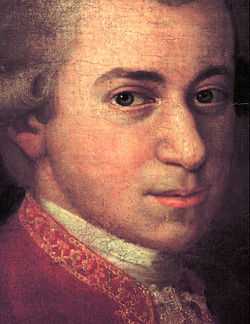Oboe Concerto (Mozart)
Wolfgang Amadeus Mozart's Oboe Concerto in C major, K. 314 was composed in the spring or summer of 1777, for the oboist Giuseppe Ferlendis (1755–1802) from Bergamo. In 1778, Mozart re-worked it as a concerto for flute in D major.[1] The concerto is a widely studied piece for both instruments and is one of the more important concerti in the oboe repertoire.[2]
Movements
As with his Flute Concerto No. 1, the piece is arranged for a standard set of orchestral strings - (violin I/II, viola and cello/double-bass doubling the bass line), two oboes, and two horns in D/C.[3] The first and last movements are in the home key of C major, while the second movement is in the subdominant key of F major.
The piece itself is divided into three movements:
Flute Concerto No. 2
The Flute Concerto No. 2 in D Major is an adaptation of the original oboe concerto. Dutch flautist Ferdinand De Jean (1731–1797) commissioned Mozart for four flute quartets and three flute concerti; which Mozart only completed three quartets and only one new flute concerto. Instead of creating a new second concerto, Mozart rearranged the oboe concerto he had written a year earlier as the second flute concerto, although with substantial changes for it to fit with what the composer deemed flute-like. However, De Jean did not pay Mozart for this concerto because it was based on the oboe concerto.[2][4]
Origin
While the original version for oboe had been lost before Alfred Einstein wrote Mozart: His Character, His Work, the oboe origin of the flute concerto was suspected then, in part because of references in letters to a now-missing oboe concerto, as Einstein wrote, and of similar details in the orchestral string lines which suggested a transposition was used. Also, Einstein noted the two scores in D Major and C Major of the K. 314 Concerto in the Library of the Gesellschaft der Musikfreunde in Vienna, which led to the belief that the oboe concerto was the origin of the flute concerto.[2] The orchestra parts of the composition and solo oboe part in C were rediscovered by Bernhard Paumgartner in Salzburg, in 1920.[1]
References
- ↑ 1.0 1.1 Mozart, W. A.; Giegling, Franz (foreword) (2003). Konzert in C für Oboe und Orchester. Klavierauszug. Kassel: Bärenreiter-Verlag. p. IV. ISMN M-00645740-3
- ↑ 2.0 2.1 2.2 Riordan, George T. (1995). "The History of the Mozart Concerto K. 314". International Double Reed Society & University of Colorado, College of Music. Archived from the original on February 7, 2007. Retrieved May 2013.
- ↑ Flute Concerto No. 2 in D major, K. 314 (K. 285d). Allmusic.
- ↑ Freed, Richard. Flute Concerto No. 2 in D major, K. 314. John F. Kennedy Center for the Performing Arts. October 5–7, 2006
External links
- Oboe Concerto in C KV 314 (285d): Score and critical report (German) in the Neue Mozart-Ausgabe
- Flute Concerto No. 2 in D KV 314 (285d): Score and critical report (German) in the Neue Mozart-Ausgabe
- Performance of Flute Concerto by the Gardner Chamber Orchestra with soloist Paula Robison from the Isabella Stewart Gardner Museum in MP3 format
- Manning, Dwight (1996). "Cadenzas and Eingänge for the Mozart Oboe Concerto, K. 314: An Annotated Bibliography". International Double Reed Society & University of Colorado, College of Music. Archived from the original on February 7, 2007. Retrieved May 2013.
| ||||||||||||||||||||
